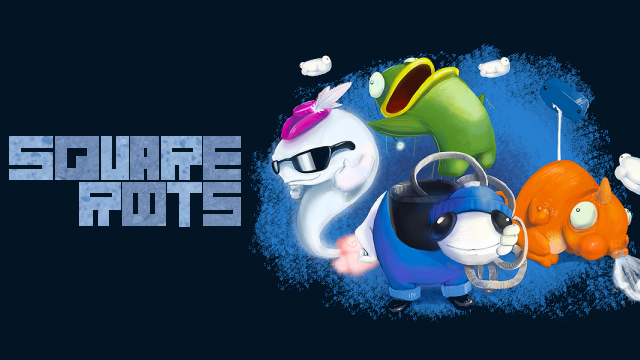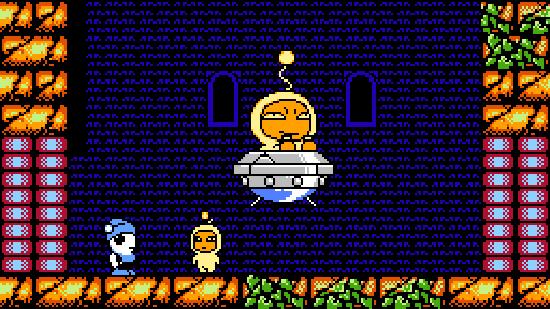
I only stumbled upon Ufouria: The Saga very recently. I have no memories of this NES game from my childhood; no recollection of reading any reviews about it and certainly don’t remember ever seeing the game staring back at me from the shelves of my local HMV. In recent years, though, the game has developed a loyal cult following of fans and fetches quite the pretty penny on eBay. This increasing interest within the gaming community made me curious as to what the big deal was, so I decided to take the plunge and download the game through Wii’s Virtual Console. I’m so glad I did because Ufouria is great– a previously undiscovered gem that deserves more widespread praise and recognition.
Released in Japan in 1991 and Europe the following year, Ufouria was published by Sunsoft towards the end of the 8-bit era– when everyone was in the process of deserting their NES and discovering the 16-bit joys of Super Mario World via their shiny new Super Famicon or Super Nintendo– and the timing of the release shows in the game’s presentation, as the large, colourful sprites and backgrounds truly bring the most out of the NES hardware.
I want to make one thing perfectly clear before continuing– I hate the name Ufouria! As you play through the game, you will indeed take take control of four main characters and, as you do so, Sunsoft expect you to feel incredibly happy about the fact you purchased the game– euphoric, even. Do you see where I’m going with this? Personally, the title drives me nuts and makes me cringe whenever I see it, but I’ll leave you to make up your own minds as to whether the title is a stroke of genius or nothing more than a lazy play on words.

Don’t get me started…
Enough of my cynicism, though, because title-quibbles aside, Ufouria is a fantastic game, and one of the best NES has to offer in my humble opinion. It’s a classic, side scrolling platformer, but in terms of structure, the game unfolds in a similar way to the original Metroid. You’re placed in a large world which you’re free to explore at your leisure, but you can only access certain areas once you’ve unlocked the different characters as they all have different, very specific abilities which you need to utilise in the correct way in order to proceed.
You start with Bop-Louie, who I can only describe as a penguin in a blue beanie hat with oversized black eyes! He can do the basics but can’t jump very high and has a tendency to fall over when walking on ice. Then you have Freeon-Leon, an orange dinosaur who can traverse said ice (because we all how well dinosaurs and ice mix). Shades is a sunglasses wearing ghost with an extreme jump, and finally there’s Gil, a frog who can walk (yes, walk) underwater. Each character also has a unique special ability which only adds to the crazy variety already on offer here.
 As you unlock these bizarre creations, more and more areas of the world map become available, and the game gives players an impressive amount of freedom as to which order they decide to complete certain tasks. Switching characters is done at the touch of the pause button, so if you fall off a platform as Bop Louie and are about to plunge to a watery death, you can simply switch to Gil mid-fall in order to survive. This mechanic works very well on the whole and allows the player a great deal of experimentation. It may not be as intuitive or logical as Metroid, but it’s still a valiant early attempt at an open world game. Playing the game today with hindsight, it becomes apparent that the game offers the illusion of freedom rather than the real thing, but when you consider that the game is over twenty years old, it still remains a damn impressive feat.
As you unlock these bizarre creations, more and more areas of the world map become available, and the game gives players an impressive amount of freedom as to which order they decide to complete certain tasks. Switching characters is done at the touch of the pause button, so if you fall off a platform as Bop Louie and are about to plunge to a watery death, you can simply switch to Gil mid-fall in order to survive. This mechanic works very well on the whole and allows the player a great deal of experimentation. It may not be as intuitive or logical as Metroid, but it’s still a valiant early attempt at an open world game. Playing the game today with hindsight, it becomes apparent that the game offers the illusion of freedom rather than the real thing, but when you consider that the game is over twenty years old, it still remains a damn impressive feat.
There are also many similarities to Yume Kōjō: Doki Doki Panic (the game which would go on to be remade as Super Mario Bros 2.), and both games look very similar and the ability to use different characters isn’t that far removed in terms of gameplay. Ufouria‘s characters also have the ability to pick up and throw objects at enemies, à la the vegetables in Mario’s second outing, but while the similarities between them are sometimes too close for comfort, I think Ufouria has just enough character and individuality to survive the comparison.
That said, the level design itself isn’t particularly inspiring– relying on the usual, forest, snow and desert areas– and the complete map is ultimately quite small. The enemies you face lack design consistency as well and are simply a succession of both the bizarre and the mundane, featuring clowns, birds which drop weights, mice wearing wooly hats to name but a few. Then there are the various bosses, which are so odd that they defy written description. The same can be said for the story which is a mystery I’ve yet to decipher.

Anyone care to explain what the hell this is all about?
In fact, if you take all of the above points individually, they aren’t that impressive. However, Ufouria overcomes this because, for all its flaws, the overall experience is memorable and will certainly leave a lasting impression. The controls are tight, the characters are loveable, and the soundtrack is one of the best I have ever heard on a NES cartridge. It’s honestly right up there with Mega Man 2 and Castlevania lll— an absolute joy to listen to!
Ufouria: The Saga will never be regarded as a true classic and perhaps that is a fitting destiny for Bop-Louie and his motley crew. The game isn’t particularly original in terms of the core gameplay ideas and you can undoubtedly find superior alternatives from the same era. Yet the thing that sticks with me is its undeniably surreal charm that seeps under your skin and refuses to go away. You’ll retire to bed humming the soundtrack to yourself and drift off dreaming of dead-eyed penguins and orange dinosaurs. It may be a slight bastardised amalgamation of a number of Nintendo’s finest– imagine if David Lynch and Miyamoto combined forces and you are on the right track– and it may not be the best game you ever play, but it has more than enough positives and quirkiness to make it well worth a download.




 ShareThis
ShareThis







This was a good read. Thank you.
The music is really nice, and has that “Sunsoft” sound to it. That’s the best way that I can explain it.
It seems like many companies in the past (especially NES and Super NES) had specific-sounding instrument sets. You can tell what’s from Capcom, Konami, etc.. Even the Follin Bros. had their own sound too, no matter what old console they created music on.
I’m certain that if this game was available in North America back then, I certainly would have paid money to play it, either through rental services or purchase at retail.